
In the Second Book of Shmuel (Samuel), 22nd chapter, 5th through the 19th verses, translated from the original in Hebrew and published by the Koren Publishers of Jerusalem, Israel, can perhaps aptly describe the fate of the crew and all other U.S.sailors who died defending their county:
"When the waves of death compassed me / the floods of ungodly men made me afraid; / the bonds of She'ol encircled me; / the snares of death took me by surprise; / in my distress I called upon the Lord, / and cried to my G-D: / and he heard my voice out of his temple, / and my cry entered into his ears. / Then the earth shook and trembled; /the foundations of heaven moved / and shook because of his anger /...the heavy mass of waters, and thick clouds of the skies /... And the channels of the sea appeared, / the foundations of the world were laid bare, / at the rebuking of the Lord, at the blast at the breath of his nostrils. / He sent from above, he took me; / he drew me out of many waters; / he delivered me from my strong enemy, and from those who hated me; for they were too strong for me. / They surprised me in the day of my calamity: / but the Lord was my stay..."
| Click On Image For Full Size |
Size | Image Description | Source | |||||||||||||||||||||||||||||||||||||||||||||||||||||||||||||||||||||||||||||||||||||||||||||||||||||||||||||||||||||||||||||||||||||||||||||||||||||||
|---|---|---|---|---|---|---|---|---|---|---|---|---|---|---|---|---|---|---|---|---|---|---|---|---|---|---|---|---|---|---|---|---|---|---|---|---|---|---|---|---|---|---|---|---|---|---|---|---|---|---|---|---|---|---|---|---|---|---|---|---|---|---|---|---|---|---|---|---|---|---|---|---|---|---|---|---|---|---|---|---|---|---|---|---|---|---|---|---|---|---|---|---|---|---|---|---|---|---|---|---|---|---|---|---|---|---|---|---|---|---|---|---|---|---|---|---|---|---|---|---|---|---|---|---|---|---|---|---|---|---|---|---|---|---|---|---|---|---|---|---|---|---|---|---|---|---|---|---|---|---|---|---|---|---|
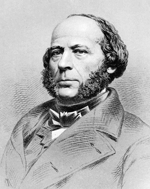 |
316k | John Ericsson, one of the 19th Century's most creative engineers and inventors, was born on 31 July 1803 in Sweden. As a youth, he joined the Swedish Army, which recognized his talents and put him to work on topographical duties. Ericsson left the Army in 1826 and moved to England, where he pursued a variety of engineering projects, among them the use of screw propellers on ships, the development of extraordinarily large guns and the creation of engines driven by hot air instead of steam. Ericsson's work attracted the attention Robert F. Stockton, an influential and progressive U.S. Navy officer, who encouraged him to relocate to the United States. During the early 1840s, the two designed a screw-propelled warship, which was commissioned in 1843 as Princeton, armed with heavy guns of their devising. The tragic explosion of one of these guns, and efforts to improperly assign the blame to Ericsson, led the strong-willed engineer to redirect his creativity into civilian fields, which he pursued successfully during the 1840s and 1850s. The outbreak of the American Civil War brought John Ericsson back into formal contact with the Navy, when he designed and produced Monitor, a revolutionary armored ship carrying her guns in a rotating turret. Monitor's successful battle with the Confederate ironclad Virginia on 9 March 1862 made Ericsson a great hero in the North. For the remainder of the conflict, he was actively involved in designing and building a large series of "Monitor"-type turret ships for the Navy. Ericsson continued his work on maritime and naval technology after the Civil War, producing ships for foreign navies and experimenting with submarines, self-propelled torpedoes and heavy ordnance. He remained active until his death in New York City on 8 March 1889. In August 1890, following a memorial service at New York, his body was placed on board the cruiser Baltimore, which carried him across the Atlantic to his native Sweden for burial. |
Image 4a26414u, courtesy of the Library of Congress via Bill Gonyo. | |||||||||||||||||||||||||||||||||||||||||||||||||||||||||||||||||||||||||||||||||||||||||||||||||||||||||||||||||||||||||||||||||||||||||||||||||||||||
 |
225k | THE ERICSSON STEEL-PLATED BATTERY. THE ERICSSON BATTERY, a sketch of which will be found on this page, is now in process of construction at the Continental Iron Works at Green Point, Long Island. She will be launched in the course of a few days. She is about 200 feet in length, with 86 feet beam and 11 feet depth of hold. Her hull is built of iron, and to protect her sides she is covered with a layer of oak 14 inches in thickness, another layer of pine 14 inches in thickness, the whole being plated with seven plates of one inch iron, making her shot-proof. A revolving fort, which contains two 12-inch guns, is placed upon the deck near the centre. This fort, or bomb-proof, is eight inches in thickness. The diameter of the fort is 20 feet inside, and it is 10 feet in height. She will be propelled by a powerful Ericsson engine. She is one of the most novel and interesting pieces of naval architecture constructed in this country. For proper reasons we forbear to give very full details in relation to this vessel, as we do not desire to give the rebels any information on such matters. Other iron-clad vessels are being built at Philadelphia, Pennsylvania, and Mystic, Connecticut. By next summer we shall have several afloat. |
Text & photos courtesy of sonofthesouth.net via Tommy Trampp. | |||||||||||||||||||||||||||||||||||||||||||||||||||||||||||||||||||||||||||||||||||||||||||||||||||||||||||||||||||||||||||||||||||||||||||||||||||||||
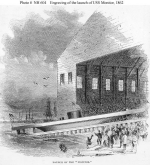 |
118k | Line engraving published of the Monitor in Harper's Weekly, September 1862, page 433, depicting the launching of the ship at the Continental Iron Works, Greenpoint, New York, on 30 January 1862. It seems unlikely that Monitor was launched with her heavy armored turret, pilothouse and other fittings already installed. | U.S. Naval Historical Center Photograph. USNHC # NH 604. | |||||||||||||||||||||||||||||||||||||||||||||||||||||||||||||||||||||||||||||||||||||||||||||||||||||||||||||||||||||||||||||||||||||||||||||||||||||||
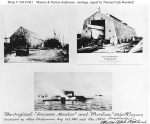 |
94k | Monitor Montage, signed by Thomas Fitch Rowland. It includes photographs of the "Monitor Shiphouse" and Puritan on the building ways at the Continental Iron Works, Greenpoint, New York, and an artwork of the battle between Monitor and CSS Virginia. The original was in the Office of Naval Records & Library Collection at the National Archives, circa the early 1960s. | U.S. Naval Historical Center Photograph. USNHC # NH 45963. | |||||||||||||||||||||||||||||||||||||||||||||||||||||||||||||||||||||||||||||||||||||||||||||||||||||||||||||||||||||||||||||||||||||||||||||||||||||||
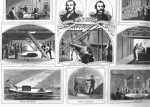 |
388k | Collage of interior scenes aboard the Monitor.
From left to right & top to bottom: Captain's Cabin. Engine Room. Berth Deck. Interior of the Tower. Turret Machinery. Ready for Action. Wheel House. Ward Room. |
Photos and text courtesy of "Harper's Pictorial History of the Civil War ", pg 252. Published by Fairfax Press and written by Henry M. Alden & Alfred H. Guernsey. | |||||||||||||||||||||||||||||||||||||||||||||||||||||||||||||||||||||||||||||||||||||||||||||||||||||||||||||||||||||||||||||||||||||||||||||||||||||||
 |
160k | Line engraving, entitled The Victorious Union Gunboat Monitor, published by Caldwell & Co., 37 Park Row, New York. Drawn by J. Seitz and engraved by Ten Eyke, it depicts the ship as she appeared before angled plating was added to the base of her pilothouse. | Courtesy of George H. Stegmann, New York. U.S. Naval Historical Center Photograph. USNHC # NH 58. | |||||||||||||||||||||||||||||||||||||||||||||||||||||||||||||||||||||||||||||||||||||||||||||||||||||||||||||||||||||||||||||||||||||||||||||||||||||||
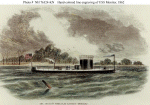 |
89k | Engraving of the Monitor, published in Harper's Weekly, 22 March 1862. This copy has been hand-colored. | Courtesy of the U.S. Navy Art Collection, Washington, D.C. U.S. Naval Historical Center Photograph. USNHC # NH 76324-KN. | |||||||||||||||||||||||||||||||||||||||||||||||||||||||||||||||||||||||||||||||||||||||||||||||||||||||||||||||||||||||||||||||||||||||||||||||||||||||
 |
724k | Line engraving published in Harper's Weekly, 1862, depicting several contemporary U.S. Navy ironclad and conventional warships. They are (from left to right: Puritan (in the original twin-turret design); Catskill; Montauk; Keokuk (citing her original name, "Woodna"); Passaic; Galena (behind Roanoke, with name not cited); Roanoke; Winona; New Ironsides; Naugatuck; Brooklyn and Monitor. | Photo # NH 58752, now in the collections of the National Archives & National Museum of the U.S. Navy via flickr.com. | |||||||||||||||||||||||||||||||||||||||||||||||||||||||||||||||||||||||||||||||||||||||||||||||||||||||||||||||||||||||||||||||||||||||||||||||||||||||
 |
86k | Transverse hull section of the Monitor through the turret. Engraving published circa 1862, based on John Ericsson's drawings, and measurements taken from the ship. | Courtesy of the Naval Historical Foundation. U.S. Naval Historical Center Photograph. USNHC # NH 60660. | |||||||||||||||||||||||||||||||||||||||||||||||||||||||||||||||||||||||||||||||||||||||||||||||||||||||||||||||||||||||||||||||||||||||||||||||||||||||
 |
153k | General plan of the Monitor published in 1862, showing the ship's inboard profile, plan view below the upper deck and hull cross sections through the engine and boiler spaces. | Courtesy of the Naval Historical Foundation. U.S. Naval Historical Center Photograph. USNHC # NH 50954. | |||||||||||||||||||||||||||||||||||||||||||||||||||||||||||||||||||||||||||||||||||||||||||||||||||||||||||||||||||||||||||||||||||||||||||||||||||||||
 |
980k | Sketch of original Monitor. | National Archives Identifier:17370270 Photo courtesy of catalog.archives.gov |
|||||||||||||||||||||||||||||||||||||||||||||||||||||||||||||||||||||||||||||||||||||||||||||||||||||||||||||||||||||||||||||||||||||||||||||||||||||||
 |
298k | Monitor plans. | National Archives Identifier:17370269 Photo courtesy of catalog.archives.gov |
|||||||||||||||||||||||||||||||||||||||||||||||||||||||||||||||||||||||||||||||||||||||||||||||||||||||||||||||||||||||||||||||||||||||||||||||||||||||
| Action Against Virginia | ||||||||||||||||||||||||||||||||||||||||||||||||||||||||||||||||||||||||||||||||||||||||||||||||||||||||||||||||||||||||||||||||||||||||||||||||||||||||||
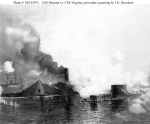 |
62k | Monitor in action with CSS Virginia, 9 March 1862. | U.S. Naval Historical Center Photograph. USNHC # NH 45973. Aquarelle facsimile print of a painting by J.O. Davidson. Collection of President Franklin D. Roosevelt. | |||||||||||||||||||||||||||||||||||||||||||||||||||||||||||||||||||||||||||||||||||||||||||||||||||||||||||||||||||||||||||||||||||||||||||||||||||||||
 |
69k | Battle between Monitor & CSS Virginia in Hampton Roads, Virginia, 9 March 1862. Lithograph by Closson Blake, after a painting by W.F. Halsall, depicting the two ironclads engaging at close range. | U.S. Naval Historical Center Photograph. USNHC # NH 1053. Collection of President Franklin D. Roosevelt. | |||||||||||||||||||||||||||||||||||||||||||||||||||||||||||||||||||||||||||||||||||||||||||||||||||||||||||||||||||||||||||||||||||||||||||||||||||||||
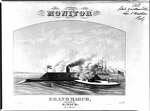 |
152k | Monitor Grand March. Sheet music covers featuring the Battle between Monitor & CSS Virginia in Hampton Roads, Virginia, 9 March 1862. | Library of Congress photo # LC-USZ62-146, from the digital archives via Tom Kermen. | |||||||||||||||||||||||||||||||||||||||||||||||||||||||||||||||||||||||||||||||||||||||||||||||||||||||||||||||||||||||||||||||||||||||||||||||||||||||
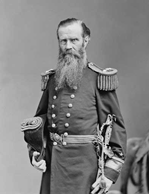 |
21k | John Lorimer Worden U.S.N. (Commander) of the Monitor. | From the Brady-Handy Photograph Collection, Library of Congress photo # LC-BH832-6, from the digital archives via Tom Kermen. | |||||||||||||||||||||||||||||||||||||||||||||||||||||||||||||||||||||||||||||||||||||||||||||||||||||||||||||||||||||||||||||||||||||||||||||||||||||||
 |
446k | Engagement between Monitor and & CSS Virginia, 9 March 1862. | Contemporary print by C. Parsons, New York, after a drawing by J. Davies. USN photo # HD-SN-99-01841, from the Defense Visual Information Center, courtesy of dodmedia.osd.mil. | |||||||||||||||||||||||||||||||||||||||||||||||||||||||||||||||||||||||||||||||||||||||||||||||||||||||||||||||||||||||||||||||||||||||||||||||||||||||
 |
39k | Monitor vs CSS Virginia, 9 March 1862. | U.S. Naval Historical Center Photograph. USNHC # NH 65686-KN. Courtesy of the Marine Midland National Bank. Painting by Rear Admiral John W. Schmidt, USN (Retired), 1967-68, located at the Marine Midland National Bank, Troy, New York. | |||||||||||||||||||||||||||||||||||||||||||||||||||||||||||||||||||||||||||||||||||||||||||||||||||||||||||||||||||||||||||||||||||||||||||||||||||||||
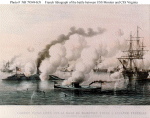 |
76k | Combat Naval Livre sur la Rade de Hampton entre l'Escadre Federale et une Division de la Marine Confederee". Colored lithograph by LeBreton, after a French officer's sketch, published in Paris, circa 1862. It depicts the 9 March 1862 battle between CSS Virginia,(called "Merrimac" on the print) and Monitor. Also shown are CSS Jamestown (left distance), Yorktown (center distance); Congress (right center distance); Cumberland (sunken in right center distance) and Minnesota (right). Congress had actually been set afire and destroyed by the Virginia on the previous day. |
U.S. Naval Historical Center Photograph. USNHC # NH 79549-KN. Courtesy of the U.S. Navy Art Collection, Washington, D.C. | |||||||||||||||||||||||||||||||||||||||||||||||||||||||||||||||||||||||||||||||||||||||||||||||||||||||||||||||||||||||||||||||||||||||||||||||||||||||
 |
110k | "The Great Fight Between the 'Merrimac' & 'Monitor', March 9th 1862."
"The First Battle Between Iron Clad Ships of War." Lithograph by Currier & Ives, New York, 1862, "From a sketch furnished by F. Newman of Norfolk, Va.", depicting the action between Monitor and CSS Virginia. |
U.S. Naval Historical Center Photograph. USNHC # 42211. Collection of President Franklin D. Roosevelt. | |||||||||||||||||||||||||||||||||||||||||||||||||||||||||||||||||||||||||||||||||||||||||||||||||||||||||||||||||||||||||||||||||||||||||||||||||||||||
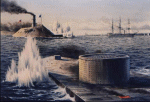 |
48k | A watercolor by the artist Richard C. Moore entitled "The Monitor and Merrimac" depicting action between Monitor and Merrimac. | Photo courtesy of ship-paintings.com. Courtesy of the artist Richard C. Moore. | |||||||||||||||||||||||||||||||||||||||||||||||||||||||||||||||||||||||||||||||||||||||||||||||||||||||||||||||||||||||||||||||||||||||||||||||||||||||
 |
147k | 1906 postcard Illustrated P.C. & Nov. Co. N.Y. entitled: Monitor and Merrimac First battle of Ironclads - Hampton Roads - 1862. | Postcard courtesy of Arnold A. Putnam. | |||||||||||||||||||||||||||||||||||||||||||||||||||||||||||||||||||||||||||||||||||||||||||||||||||||||||||||||||||||||||||||||||||||||||||||||||||||||
 |
175k | 1907 postcard by American Colortype Co. N.Y. entitled: Battle between the Monitor and Merrimac. | Postcard courtesy of Arnold A. Putnam. | |||||||||||||||||||||||||||||||||||||||||||||||||||||||||||||||||||||||||||||||||||||||||||||||||||||||||||||||||||||||||||||||||||||||||||||||||||||||
 |
215k | "The Battle between the 'Monitor' and the 'Merrimac', in Hampton Roads, March 9, 1862". Line engraving published in Harper's Weekly January-June 1862, page 237, based on a drawing by Sergeant Charles Worret, Twentieth Regiment New York Volunteers. The view looks approximately south, from over Fortress Monroe, and provides a panoramic view of the action, with many elements keyed to text below the picture. Numbered features, as cited below the view, include: (Note: numbers 1-13 run across the upper part of the view, from left center to right): 1. Sewell's Point Battery, 30 Guns; 2. Craney Island Battery, 42 Guns; 3.CSS Yorktown 4.CSS Jamestown; 5.Monitor; 6. Merrimac; 7. Large Rebel Camp; 8.Minnesota aground; 9. Pig Point Battery; 10. Barrel Point Battery; 11. Burning of the Congress; 12. The Cumberland sunk; 13. Newport News Point and Camp; 14. St. Lorenze ... (small vessel near Minnesota); 15. Hampton; 16. Rip Raps (at far left); 17. French Man-of-War (left center); 18. Whitehall. Ships in the left foreground include Roanoke with Union transports and storeships. |
Photo courtesy of "Harper's Pictorial History of the Civil War ", pg 256. Published by Fairfax Press and written by Henry M. Alden & Alfred H. Guernsey. Text courtesy of USNHC NH 59223. | |||||||||||||||||||||||||||||||||||||||||||||||||||||||||||||||||||||||||||||||||||||||||||||||||||||||||||||||||||||||||||||||||||||||||||||||||||||||
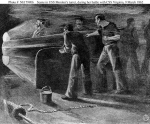 |
127k | "The Monitor's Heros at work in the Turret". Artwork published in "Deeds of Valor", Volume II, page 17, by the Perrien-Keydel Company, Detroit, 1907. It depicts turret crewmen of Monitor working their eleven-inch guns, during the battle with CSS Virginia, 9 March 1862. | U.S. Naval Historical Center Photograph. USNHC # NH 79906. | |||||||||||||||||||||||||||||||||||||||||||||||||||||||||||||||||||||||||||||||||||||||||||||||||||||||||||||||||||||||||||||||||||||||||||||||||||||||
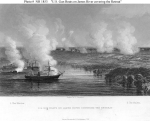 |
97k | "U.S. Gun Boats on James River covering the Retreat."
Engraving after a drawing by C. Parsons, published by Virtue, Yorston & Company, New York, circa the later 19th Century. It depicts the ironclads Monitor, and Galena bombarding Confederate forces as General McClellan's army withdraws following the Battle of Malvern Hill, 2 July 1862. The other two ships visible are probably Aroostook [beyond Monitor's bow] and Jacob Bell [behind Monitor, at left]. |
U.S. Naval Historical Center Photograph. USNHC # 1853. | |||||||||||||||||||||||||||||||||||||||||||||||||||||||||||||||||||||||||||||||||||||||||||||||||||||||||||||||||||||||||||||||||||||||||||||||||||||||
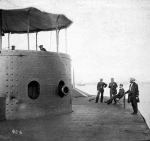 |
769k | View on deck looking forward on the starboard side, while the ship was in the James River, Virginia, 9 July 1862. The turret, with the muzzle of one of Monitor's two XI-inch Dahlgren smoothbore guns showing, is at left. Note dents in turret armor from hits by Confederate heavy guns and crewmembers atop the turret. Officers at right are (left to right): Third Assistant Engineer Robinson W. Hands, Acting Master Louis N. Stodder, Second Assistant Engineer Albert B. Campbell (seated) and Acting Volunteer Lieutenant William Flye (with binoculars). |
Text courtesy of U.S. Naval Historical Center Photograph USNHC # 61923. Photo # HD-SN-99-01842 from the Defense Visual Information Center, courtesy of dodmedia.osd.mil. | |||||||||||||||||||||||||||||||||||||||||||||||||||||||||||||||||||||||||||||||||||||||||||||||||||||||||||||||||||||||||||||||||||||||||||||||||||||||
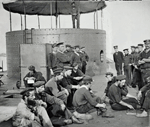 monitor1v | 1.96k | Crewmen relaxing on deck, while the ship was in the James River, Virginia, on 9 July 1862. View looks forward on the starboard side, with the gun turret beyond. Note men playing checkers at right. Another man is reading a newspaper by the starboard smokestack | U.S. Naval Historical Center Photograph. USNHC # 574 via Robert Canchola. | |||||||||||||||||||||||||||||||||||||||||||||||||||||||||||||||||||||||||||||||||||||||||||||||||||||||||||||||||||||||||||||||||||||||||||||||||||||||
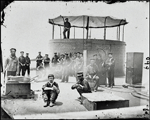 monitor1w | 1.51k | Crewmembers cooking on deck, in the James River, Virginia, 9 July 1862. This view looks forward from the port quarter, with the port side blower hatch in the foreground, the two smokestacks in the middle distance and the turret beyond. The sailor standing atop the turret is holding a telescope. Note cookstove supported on bricks at left and awning above the turret. | U.S. Naval Historical Center Photograph. USNHC # 73688. Courtesy of the Library of Congress. Photographed by James F. Gibson via Robert Canchola. | |||||||||||||||||||||||||||||||||||||||||||||||||||||||||||||||||||||||||||||||||||||||||||||||||||||||||||||||||||||||||||||||||||||||||||||||||||||||
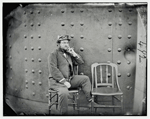 monitor2s |
317k | Capt. W.N. Jeffers on the deck of the Monitor in the James River, Virginia on 9 July 1862. (Notice what appears to be a dent from a cannon ball on the right). | Photo by James F. Gibson from the Library of Congress digital archives via Robert Canchola. | |||||||||||||||||||||||||||||||||||||||||||||||||||||||||||||||||||||||||||||||||||||||||||||||||||||||||||||||||||||||||||||||||||||||||||||||||||||||
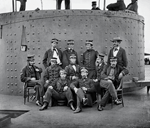 monitor2k |
867k | Top row, left to right: Second Assistant Engineer Albert B. Campbell; Third Assistant Engineer Mark Trueman Sunstrom; Acting Assistant Paymaster William F. Keeler; and Lieutenant L. Howard Newman (Executive Officer of Galena. Middle Row, left to right: Acting Master Louis N. Stodder; Master's Mate George Frederickson; Acting Volunteer Lieutenant William Flye; Acting Assistant Surgeon Daniel C. Logue; and Lieutenant Samuel Greene. Seated on deck in front, left to right: Third Assistant Engineer Robinson W. Hands and Acting Master E.V. Gager. | USN photo NH 61931 via Robert Canchola. | |||||||||||||||||||||||||||||||||||||||||||||||||||||||||||||||||||||||||||||||||||||||||||||||||||||||||||||||||||||||||||||||||||||||||||||||||||||||
 monitor10 |
1.00k | Monitor gun deck. | USN photo via Robert Canchola. | |||||||||||||||||||||||||||||||||||||||||||||||||||||||||||||||||||||||||||||||||||||||||||||||||||||||||||||||||||||||||||||||||||||||||||||||||||||||
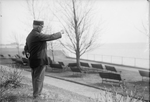 |
109k | John Driscoll, veteran of fight between Monitor & Merrimac pointing to spot in Hampton Roads where battle occurred. | Library of Congress photo # Photo LC-DIG-hec-06643 & text courtesy of the Harris & Ewing Collection. | |||||||||||||||||||||||||||||||||||||||||||||||||||||||||||||||||||||||||||||||||||||||||||||||||||||||||||||||||||||||||||||||||||||||||||||||||||||||
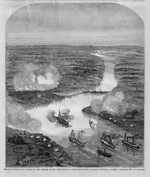 |
873k | Civil War wood-cut engraving/print is titled "BALLOON VIEW OF THE ATTACK ON FORT DARLING, IN THE JAMES RIVER, BY COMMANDER ROGERS'S GUN-BOAT FLOTILLA, GALENA, MONITOR, ETC.", published in Harper's Weekly, May 1862. | Photo courtesy of Tommy Trampp. | |||||||||||||||||||||||||||||||||||||||||||||||||||||||||||||||||||||||||||||||||||||||||||||||||||||||||||||||||||||||||||||||||||||||||||||||||||||||
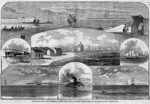 |
1.45k | Civil War wood-cut engraving/print is titled "THE SECOND TRIP OF THE MERRIMAC--SCENES AT AND AROUND FORTRESS MONROE", published in "Harper's Weekly", May 1862. | Photo courtesy of Tommy Trampp. | |||||||||||||||||||||||||||||||||||||||||||||||||||||||||||||||||||||||||||||||||||||||||||||||||||||||||||||||||||||||||||||||||||||||||||||||||||||||
 |
389k | Monitor, Watercolor by Oscar Parkes. | Photo # NH 59543, courtesy of Dr. Oscar Parkes, 1936. U.S. Naval History and Heritage Command Photograph, from the National Museum of the U.S. Navy via flickr.com. | |||||||||||||||||||||||||||||||||||||||||||||||||||||||||||||||||||||||||||||||||||||||||||||||||||||||||||||||||||||||||||||||||||||||||||||||||||||||
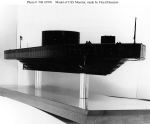 |
58k | Model of the Monitor made by Floyd Houston, probably photographed at the Truxtun-Decatur Naval Museum, Washington, D.C., circa 1964. | Courtesy of the Naval Historical Foundation. U.S. Naval Historical Center Photograph. USNHC # NH 45976. | |||||||||||||||||||||||||||||||||||||||||||||||||||||||||||||||||||||||||||||||||||||||||||||||||||||||||||||||||||||||||||||||||||||||||||||||||||||||
| Loss & Discovery | ||||||||||||||||||||||||||||||||||||||||||||||||||||||||||||||||||||||||||||||||||||||||||||||||||||||||||||||||||||||||||||||||||||||||||||||||||||||||||
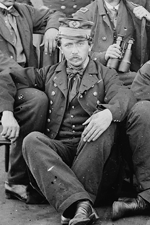 |
127k | Missing from the sinking of Monitor Acting Ensign Norman Atwater Acting Ensign George Frederickson was last seen manning the pumps in an attempt to keep the Monitor afloat. Third Assistant Engineer Robinson W. Hands was probably in the engine room along with Third Assistant Engineer Samuel A. Lewis; First-Class Fireman Thomas Joice; First-Class Robert Williams; and Coal Heaver George Littlefield. All were lost. Boatswain's Mate Wells Wentz (shipped out as John Stocking, a name he picked from a Reverend who lived in his town in Binghamton, a common practice among enlisted in they decided to desert the navy) served with the Monitor during her historic engagement with the Virginia, and was on board the ill-fated iron clad when she was being towed south by the Rhode Island. When the Monitor foundered during a force gail storm, on the night of 31 December 1862, Wentz volunteered to go forward and attempt to cut through the heavy hawser connecting her to the Rhode Island. He was swept overboard and drowned, becoming one of the sixteen officers and men lost with the historic iron clad. He was transferred from the Sabine to the Monitor on 6 March 1862 just prior to her encounter with the Virginia. Wells Wentz was born in Binghamton N.Y. 18 August 1830. Quarter Gunner James Fenwick Yeoman William Bryan Officer's Steward Daniel Moore Officer's Cook Robert Howard Landsman William Allen Landsman William Eagan Ordinary Seaman Jacob Nickles First-Class Boy Robert Cook |
Wells Wentz photo courtesy of Heritage Auctions Image of Jacob Nickles was provided courtesy of the Kill Devil Hills Lifesaving Station. Image of Engineer Robinson Woollen Hands was provided courtesy of the Library of Congress, Image #535u, all via Bill Gonyo. |
|||||||||||||||||||||||||||||||||||||||||||||||||||||||||||||||||||||||||||||||||||||||||||||||||||||||||||||||||||||||||||||||||||||||||||||||||||||||
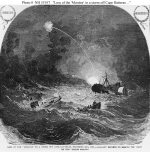 |
163k | Loss of the Monitor in a Storm off Cape Hatteras, 30 December 1862. Gallant efforts to rescue the crew by the Rhode Island" Line engraving published in "The Soldier in Our Civil War", Volume I, page 248. It shows Monitor sinking at left, with a boat picking up crewmen, as Rhode Island stands by in the right background, firing rockets. |
U.S. Naval Historical Center Photograph. USNHC # 51957. | |||||||||||||||||||||||||||||||||||||||||||||||||||||||||||||||||||||||||||||||||||||||||||||||||||||||||||||||||||||||||||||||||||||||||||||||||||||||
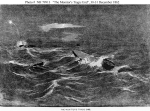 |
163k | "The Monitor's Tragic End". Artwork published in "Deeds of Valor", Volume II, page 39, by the Perrien-Keydel Company, Detroit, 1907. It depicts Monitor sinking off Cape Hatteras during the night of 30-31 December 1862, as a boat approaches to rescue some of her crewmen. Rhode Island is in the left distance, firing a rocket. |
U.S. Naval Historical Center Photograph. USNHC # 79913. | |||||||||||||||||||||||||||||||||||||||||||||||||||||||||||||||||||||||||||||||||||||||||||||||||||||||||||||||||||||||||||||||||||||||||||||||||||||||
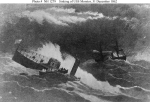 |
118k | Loss of the Monitor, 30-31 December 1862. Halftone reproduction of a Civil War era print, copied from the "U.S. Naval Institute Proceedings", December 1926. Rhode Island is standing by in the background, as a boat removes crewmen from the sinking Monitor. |
U.S. Naval Historical Center Photograph. USNHC # 1279. | |||||||||||||||||||||||||||||||||||||||||||||||||||||||||||||||||||||||||||||||||||||||||||||||||||||||||||||||||||||||||||||||||||||||||||||||||||||||
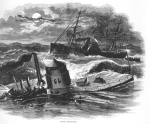 |
219k | Loss of the Monitor Depicting Monitor sinking in a storm off Cape Hatteras on the night of 30-31 December 1862. A boat is taking off crewmen, and Rhode Island is in the background. |
Photo and partial text courtesy of "Harper's Pictorial History of the Civil War" pg 258. Published by Fairfax Press and written by Henry M. Alden & Alfred H. Guernsey. Other text courtesy of USNHC NH 58758. | |||||||||||||||||||||||||||||||||||||||||||||||||||||||||||||||||||||||||||||||||||||||||||||||||||||||||||||||||||||||||||||||||||||||||||||||||||||||
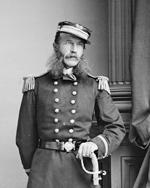 |
206k | John Payne Bankhead was the last commanding officer of the Monitor and took command from Thomas Holdup Stevens II on 10 September 1862. Shortly after Bankhead took command the Monitor's boilers and engines were condemned, and on 3 October 1862, the ironclad arrived at the Washington Navy Yard for repairs. By November the ship was finished and returned to Hampton Roads. Orders were issued on 24 December 1862, for the Monitor to move to Beaufort, North Carolina. There the ship would join the blockade off Charleston. On Christmas Day the Monitor was ready for sea, but bad weather delayed departure until 29 December. On 31 December 1862, a storm hit seas off Hatteras, and the Monitor, under tow by the Rhode Island, foundered and sank with the loss of four officers and 16 men during a force 7 gale. Bankhead himself was saved but suffered from exposure. | Image 06301u, courtesy of the Library of Congress via Bill Gonyo. | |||||||||||||||||||||||||||||||||||||||||||||||||||||||||||||||||||||||||||||||||||||||||||||||||||||||||||||||||||||||||||||||||||||||||||||||||||||||
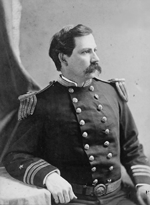 |
457k | Samuel Dana Greene was born in Cumberland, Maryland, son of future U.S. Army General George S. Greene. He graduated from the United States Naval Academy in 1859 and became a lieutenant two years later. He was executive officer of the Monitor during its historic five-hour battle with ironclad CSS Virginia 9 March 1862 and assumed command after Captain John Lorimer Worden was wounded in the pilot-house and was attempting to re-engage the Virginia, however the Virginia had already turned away toward Norfolk. He served as her only executive officer on the Monitor in the engagements on the James River, Virginia, April to May 1862, and when the ship founderedin a gale on 31 December 1862, which Greene survived after being pulled into a lifeboat by the ship's surgeon, Dr. Grenville M. Weeks. He served with distinction throughout the Civil War. | Image by permission of the Mariners' Museum Collections via Bill Gonyo. | |||||||||||||||||||||||||||||||||||||||||||||||||||||||||||||||||||||||||||||||||||||||||||||||||||||||||||||||||||||||||||||||||||||||||||||||||||||||
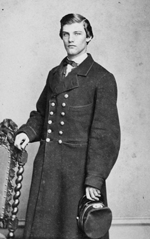 |
793k | Mark Trueman Sunstrom was working as a bookkeeper in Baltimore, Maryland prior to joining the navy. He was appointed and commissioned 3rd Assistant Engineer on 1 February 1862 and eventually promoted to 2nd Assistant Engineer on 15 October 1863. He joined the Monitor while she was still under construction on the banks of the East River in Greenpoint, Brooklyn, and served aboard the Monitor until she foundered at sea on 30 December 1862. He served aboard the Unadillo; Pontoosuc and Ashuelot during the course of the war in the North Atlantic Blockading Squadron until he resigned on 10 November 1865 as a result of a disability incurred in service. | Information was obtained from the Ancestry.com and the book "History of Sailors and Marines Maryland Volunteers, Civil War, 1861-1865". Image from the Mariners Museum by permission via Bill Gonyo. | |||||||||||||||||||||||||||||||||||||||||||||||||||||||||||||||||||||||||||||||||||||||||||||||||||||||||||||||||||||||||||||||||||||||||||||||||||||||
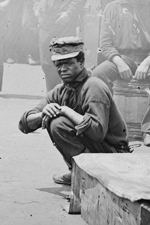 |
87k | Like many other African American slaves, Siah Carter sought freedom and refuge in the Union Navy along the myriad waterways of the southern interior. At the time he joined the Union Navy, Carter was a slave at the Shirley Plantation in Charles City, Virginia. He became the first of eighteen slaves to escape from Shirley Plantation in 1862, Twenty-two year old Carter fled down the James River two months after the Battle of Hampton Roads, finding Monitor lying at anchor. He enlisted aboard the ironclad as a "first class boy," serving as a coal heaver and cook's assistant for the duration of the ship's short existence. Carter survived the sinking of the famed vessels in December 1862, going on to serve on several other Union ships until the end of the war. He was discharged from the Union Navy in May 1865. | Text from the blog "Civil War Navy Sesquicentennial". Image # 00306u courtesy of the Library of Congress via Bill Gonyo. | |||||||||||||||||||||||||||||||||||||||||||||||||||||||||||||||||||||||||||||||||||||||||||||||||||||||||||||||||||||||||||||||||||||||||||||||||||||||
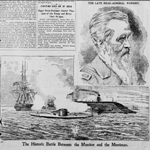 |
NR | AN AGED HERO IS AT REST Death of Rear-Admiral Worden, the Monitor's Commander. |
Image and text provided by University of California, Riverside. Photo courtesy of The San Francisco Call. (San Francisco [Calif.]) 1895-1913, 19 October 1897, Image 3, via chroniclingamerica.loc.gov. | |||||||||||||||||||||||||||||||||||||||||||||||||||||||||||||||||||||||||||||||||||||||||||||||||||||||||||||||||||||||||||||||||||||||||||||||||||||||
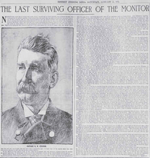 |
1.60k | The last surviving officer of the Monitor. | Image and text provided by Library of Congress, Washington, DC. Photo by Deseret Evening News.(Washington [D.C.])(Great Salt Lake City [Utah]) 1867-1920, 25 January 1902, courtesy of chroniclingamerica.loc.gov. | |||||||||||||||||||||||||||||||||||||||||||||||||||||||||||||||||||||||||||||||||||||||||||||||||||||||||||||||||||||||||||||||||||||||||||||||||||||||
 |
707k | Relics of Navy's First Iron Ship That Was Destined to Revolutionize Naval Fighting Forces of World Now in Navy Department Library. | Image and text provided by Arizona State Library, Archives and Public Records; Phoenix, AZ. Photo by Bisbee Daily Review. (Bisbee, Ariz.) 1901-1971, 8 September 1910, Image 1, courtesy of chroniclingamerica.loc.gov. | |||||||||||||||||||||||||||||||||||||||||||||||||||||||||||||||||||||||||||||||||||||||||||||||||||||||||||||||||||||||||||||||||||||||||||||||||||||||
 |
NR | FROM THE MONITOR TO THE LATEST DREADNOUGHT | Image and text provided by The New York Public Library, Astor, Lenox and Tilden Foundation. Photo from The Sun. (New York [N.Y.]) 1833-1916, 25 February 1912, FOURTH SECTION, Image 45, via chroniclingamerica.loc.gov. 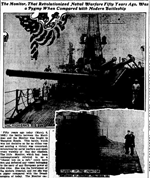 NR | The Monitor, That Revolutionized Naval Warfare Fifty Years Ago, Was a Pygmy When Compared With Modern Battleship | Image and text provided by State Historical Society of North Dakota. | Photo by Bismarck Daily Tribune. (Bismarck, Dakota [N.D.]) 1881-1916, 09 March 1912, Image 1, courtesy of chroniclingamerica.loc.gov. 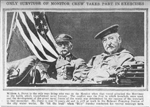 715k |
ONLY SURVIVOR OF MONITOR CREW TAKES PART IN EXERCISE |
William A. Durst is the only man living who was on the Monitor when that vessel attacked the Merrimac in the battle which transformed naval history. The conflict was the first in which ironclads were used, and the development of the great naval forces of the world was determined by the success of the ironclads in that encounter. Mr. Durst is over 75 years old and is still at work in the Belmont Pumping Station of the city water works. He "hit the trail" when "Billy" Sunday conducted his revival meetings here. Image and text provided by Penn State University Libraries; University Park, PA. | Photo by Evening Public Ledger. (Philadelphia [Pa.]) 1914-1942, 31 May 1915, Night Extra, Image 3, courtesy of chroniclingamerica.loc.gov.  455k |
FIRING SQUAD PAYS LAST HONOR TO WILLIAM DURST. |
Marines from the Navy Yard discharged a volley over the grave of the last survivor of the Monitor, forerunner of the modern turreted battleship, after the body was interred yesterday afternoon in Mt. Carmel Cemetery. Image and text provided by Penn State University Libraries; University Park, PA. | Photo by Evening Public Ledger. (Philadelphia [Pa.]) 1914-1942, 08 January 1916, Night Extra, Image 22, courtesy of chroniclingamerica.loc.gov. 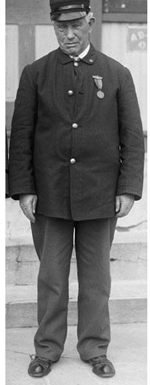 441k |
The obituary of the REAL last survivors of the Monitor appear here. |
John Ambrose Driscoll, First-Class Fireman, was the last survivor of the ship's engagement with the Virginia. He died on 13 June 1921, in Philadelphia. Ordinary Seaman Isaac H. Scott is the last documented survivor of the Monitor, surviving her sinking on 31 December 1862. He died in Buffalo on 17 May 1927. Image and text provided by Steve Glazer, LTC, USA (ret.)
|  79k |
Photographic mosaic of the ship's remains, composed of individual photographs taken from the research ship Alcoa Seaprobe in April 1974, when Monitor's wreck was initially discovered.
Monitor lies upside down, in badly damaged condition, off Cape Hatteras, North Carolina. In this image, her bow is to the right, with her turret displaced and visible in the lower left, with the hull resting atop it.
|
U.S. Naval Historical Center Photograph. USNHC # 96723. |
 35k |
Sketch of the ship's remains: Monitor lies upside down, in badly damaged condition, off Cape Hatteras, North Carolina. In this image, her bow is to the right, with her turret displaced and visible in the lower left, with the hull resting atop it.
|
Photo courtesy Pre-Dreadnought Preservation by Mark Howells, courtesy of Atlantic Wreck Divers of Maryland. |
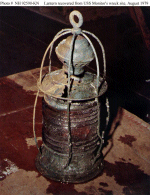 84k |
Lantern recovered from the Monitor's wreck site in August 1979. It was photographed soon after recovery, before conservation work had begun.
|
U.S. Naval Historical Center Photograph. USNHC # 92590-KN. |
 808k |
Monitor's wreck off the coast of Cape Hatteras, 1987. |
Images courtesy of NOAA. | Photo from Lost Warships: An Archaeological Tour of War at Sea by James P. Delgado via Robert Hurst.  20k |
Commemorative post mark from the Naval Sea Systems Command Deep Submergence Vessel "Deep Drone" dive on the Monitor, 9 March 1987. |
Photo courtesy of Jack Treutle (of blessed memory).
|
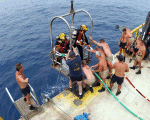 375k |
Atlantic Ocean, 1 July 2002, Senior Chief Boatswain's Mate Jim Mariano (far left) gives instructions to the winch operator as divers are "swung-in" during the "up-and-over" phase of a dive on the sunken Civil War ironclad, Monitor. Monitor rests 240 feet below the ocean's surface. Diving operations are designed to prepare the 22 foot diameter turret and 11-inch Dahlgren guns for salvage and recovery. |
USN photo # N-7479T-001, by Chief Photographer's Mate Eric J. Tilford, courtesy of news.navy.mil.
|
 345k |
Atlantic Ocean, 1 July 2002, Chief Hospital Corpsman Mitch Pearce makes adjustments to the saturation air system during a dive on the sunken Civil War ironclad, Monitor, which rests 240 feet below the ocean's surface. |
USN photo # N-7479T-003, by Chief Photographer's Mate Eric J. Tilford, courtesy of news.navy.mil.
|
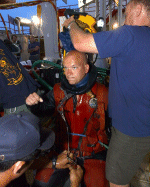 269k |
Atlantic Ocean, 1 July 2002, Master Chief Hull Maintenance Technician Scott Heineman prepares to enter the water for a dive on the sunken Civil War ironclad, Monitor. Heineman is a Navy Master Diver taking part in the efforts to salvage and recover the turret of the submerged battleship which rests 240 feet below the surface of the Atlantic. |
USN photo # N-3725V-001, by Photographer's Mate 1st Class Chadwick Vann, courtesy of news.navy.mil.
|
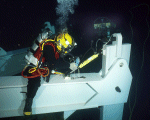 199k |
At sea off the coast of Cape Hateras, N.C. on 21 July 2002, Hull Technician 1st Class John Coffelt works on a hydraulic ram as a remote operated vehicle (ROV) looks on during a dive on the sunken Civil War Ironclad, Monitor, which rests 230 feet below the ocean's surface. The ram will be used to articulate a leg of the "spider" apparatus that will lift the turret. |
USN photo # N-7479T-002, by Chief Photographer's Mate Eric J. Tilford, courtesy of news.navy.mil.
|
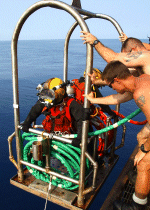 337k |
At sea off the coast of Cape Hateras, N.C., 21 July 2002, divers from Mobile Diving and Salvage Unit Two (MDSU-2), Little Creek Amphibious Base, Norfolk VA, prepare to enter the water to make a dive on the sunken civil war Ironclad, Monitor. MDSU-2 is taking part in efforts to recover the turret of the battleship for display. Because the wreck sits at a depth of 230 feet, divers are limited to approximately 30 minutes of "bottom time" for each dive. |
USN photo # N-3725V-003, by Photographer's Mate 1st Class Chadwick Vann, courtesy of news.navy.mil.
|
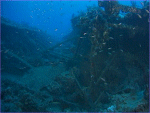 38k |
Wreck of the Monitor off the coast of Cape Hateras, N.C. in 240 feet of water. |
Photo courtesy of freerepublic.com. |
 monitor5 1.32k |
A letter from John Beckley, owner of the North Adams Iron Co., to John Winslow, owner of the Albany Iron Works in Troy, N.Y., dated 1861, speaks of an order of 50 tons of No. 1 pig iron. Beckley states he is "making the iron from Copake Ore." Beckley owned an ironworks in Copake, N.Y. Winslow and his business partner, John Griswold, worked with John Ericsson to build the Monitor. |
3 photo PDF showing in order the following photos: The turret of the Civil War ironclad Monitor is visible through the bubble of the Johnson-Sea-Link II mini-sub, as it rests on the ocean floor, 240 feet below the surface, off Cape Hatteras, N.C., in 2002. Chris Murray, aboard the salvage vessel Kellie Chouest off Cape Hatteras, N.C., in 1998, adjusts packing for a deck plate brought up from the wreckage of the Civil War ironclad Monitor. The turret of the Civil War ironclad Monitor is lifted out of the Atlantic Ocean off Cape Hatteras, N.C., in 2002, nearly 140 years after the historic warship sank during a storm. Pig iron, smelted at the North Adams Iron Co., was said to be used in the creation of the iron plates on the turret. Photos courtesy of berkshireeagle.com written by Jennifer Huberdeau & submitted by Tommy Trampp.
|  379k |
Monitor's turret is recovered.
|
Photograph courtesy of The Mariners Museum courtesy of the N.Y.Times, 8 August 2011. |
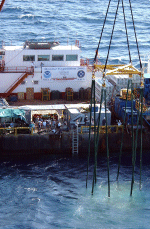 779k |
Personnel from the U.S. Navy, The National Oceanographic and Atmospheric Agency (NOAA), Phoenix International, and the Mariners Museum of Newport News, VA, hoist the gun turret of the Civil War ironclad, Monitor onto the deck of the derrick barge Wotan off Cape Hatteras, N.C. on 5 August 2002. Since its designation as our nation's first marine sanctuary in 1975, the Monitor has been the subject of intense investigation. The turret was the first revolving gun of its kind and will eventually be on public display in the Mariners' Museum in Newport News, Va. |
USN photo # N-0872M-524, by Photographer's Mate 1st Class Martin Maddock, courtesy of news.navy.mil.
|
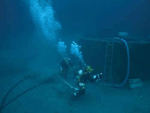 38.5k |
Monitor turret recovery off the coast of Cape Hateras, N.C. in 240 feet of water. |
20 page PDF of the November 2002 edition of Faceplate, The Official Newsletter for the Divers & Salvors of the USN. Photo courtesy of Faceplate. |
 248k |
The historic Worden Sword rests on a table with its belt and scabbard laid out for display. The FBI recovered the priceless sword missing since 1931, and returned it to the U.S. Naval Academy at a press conference at Annapolis, Md., 12 January 2004. The Tiffany sword was originally presented to Rear Adm. John L. Worden by the state of New York for his command of Monitor in its famous battle with Virginia in Hampton Roads, Va., 9 March 1862. Rear Adm. Worden also served as the seventh Superintendent of the U.S. Naval Academy. |
USN photo # N-0000X-001, by Cliff Maxwell, courtesy of news.navy.mil.
|
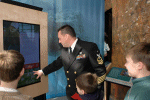 95k |
Senior Chief Hospital Corpsman Scott Allison, leading chief petty officer of Explosive ordnance Disposal (EOD) Mobile Unit (MOBU) 2, explains an interactive video of the inner workings of the turret on the Monitor to his children during a visit to the Monitor Center in Newport News, Va. on 9 March 2007. |
USN photo by Mass Communication Specialist Seaman John Suits, courtesy of news.navy.mil. |
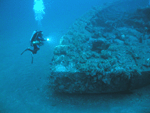 176k |
Monitor's wreck off the coast of Cape Hatteras, 2008. |
Photo courtesy of NOAA.
| Replica / Today |
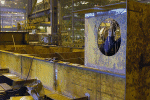 504k |
Northrop Grumman Newport News employees will build the Monitor replica in 22 steel sections inside the shipyard's steel production facility. Pictured on 21 February 2005, is the first section, called the keel unit, which weighs approximately 18 tons and is about the size of a rail car.
|
Photo # 189-1426, by Chris Oxley, courtesy of Northrop Grumman. |
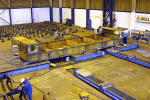 607k |
Northrop Grumman Newport News employee Josh Cantrell welds the keel section of the Monitor replica in preparation for a March 6 keel laying ceremony. |
Photo # 189-1427, by Chris Oxley, courtesy of Northrop Grumman. |
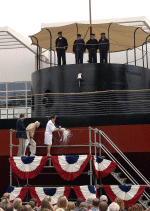 377k |
(From left) The Mariners' Museum President and CEO John Hightower and famed author Clive Cussler lean in to watch as Nancy Petters, the ship's sponsor and wife of Northrop Grumman Newport News President Mike Petters, christens the Monitor replica with a bottle of American sparkling wine.
|
Photo # 061206C, by John Whalen, courtesy of Northrop Grumman. |
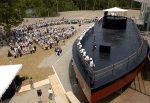 504k |
During the christening ceremony, 40 apprentices from the sector's apprentice school manned the ship. Apprentices built the replica in 22 steel sections using data provided by engineers from the CVN-21 aircraft carrier program.
|
Photo # 061206E, by John Whalen, courtesy of Northrop Grumman. |
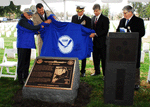 407k |
The memorial monument for Monitor is revealed at the Hampton National Cemetery. 31 December 2012 marks the 150th anniversary of the sinking of the Monitor which foundered during extreme weather off the coast of Cape Hatteras. |
USN photo 121229-N-YT478-042 by Mass Communication Specialist 1st Class Lolita Lewis via Ron Reeves (of blessed memory).
|  259k |
Members of the U.S. Navy Ceremonial Guard carry the casket containing the remains of one of two unknown sailors who were lost when the Monitor, the nation's first ironclad warship, sank 31 December 1862, in a storm off Cape Hatteras, N.C., from a Delta MD-88 aircraft, at Dulles International Airport in Chantilly, Va., 7 March 2013, during a dignified transfer ceremony. |
Photo courtesy of Carolyn Kaster/AP.
| 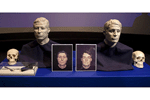 213k |
The Navy buried two sailors found in the turret of the Monitor, the famed Civil War ironclad. Forensic anthropologists reconstructed their likenesses, but their identities are a mystery.
|
Photo courtesy of Carolyn Kaster/AP.
| | |||||||||||||||||||||||||||||||||||||||||||||||||||||||||||||||
USS MONITOR History
View This Vessels DANFS History Entry
(Located On The Hazegray & Underway Web Site, This Is The Main Archive For The DANFS Online Project.)
Crew Contact And Reunion Information
Not Applicable To This Ship
Additional Resources
Hazegray & Underway Battleship Pages By Andrew Toppan.
Monitor National Marine Santuary, NOAA.
CambrianFoundation.org USS Monitor, The Sinking.
Tour the Wreck of the Monitor.
Pre-Dreadnought Preservation, The U.S.S. Monitor by Mark Howells
| Back To The Main Photo Index | Back To The Battleship Photo Index Page |
This page is created and maintained by Michael Mohl
All Pages © 1996 - 2024, by Paul R. Yarnall NavSource Naval History. All Rights Reserved.